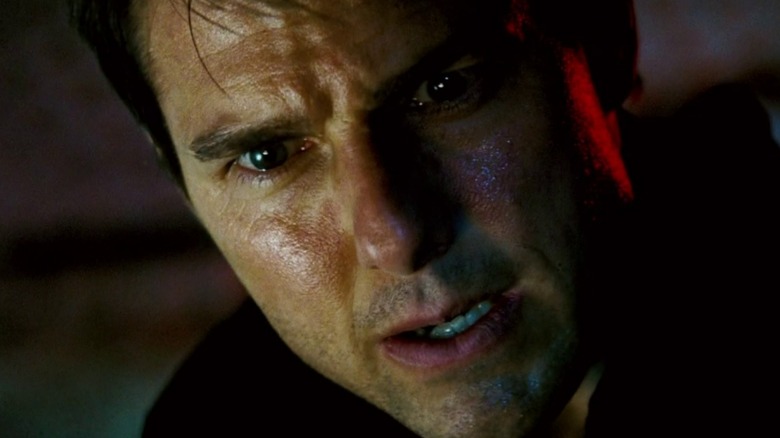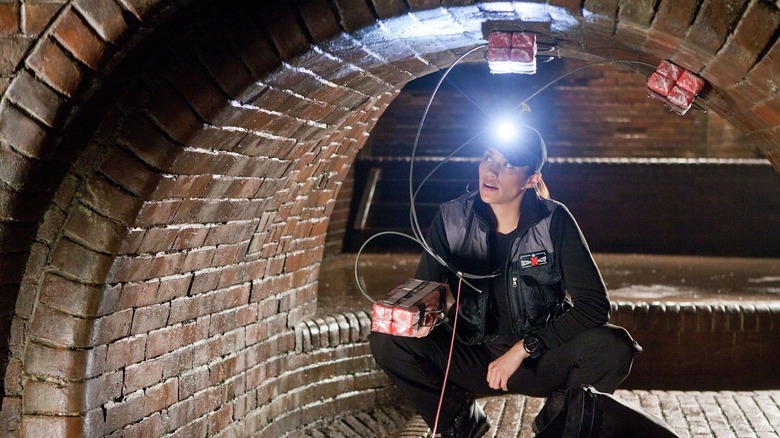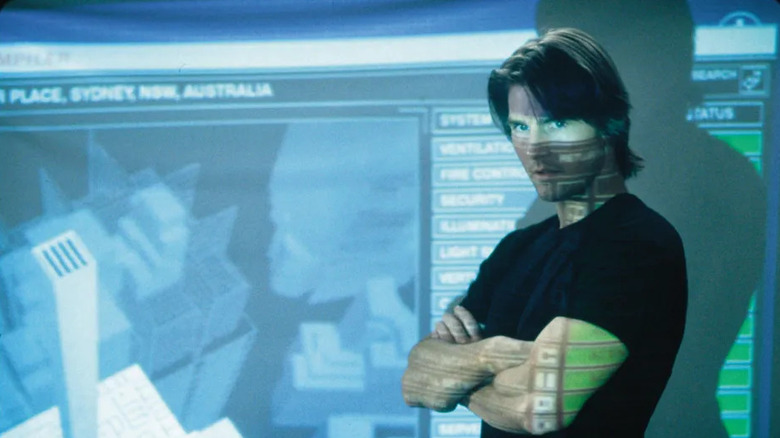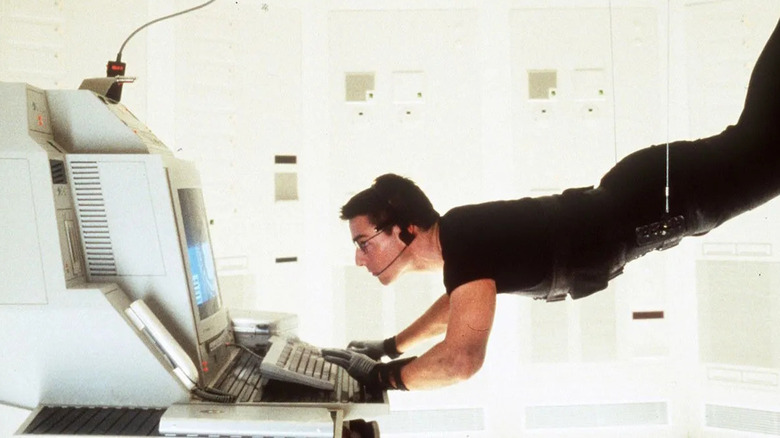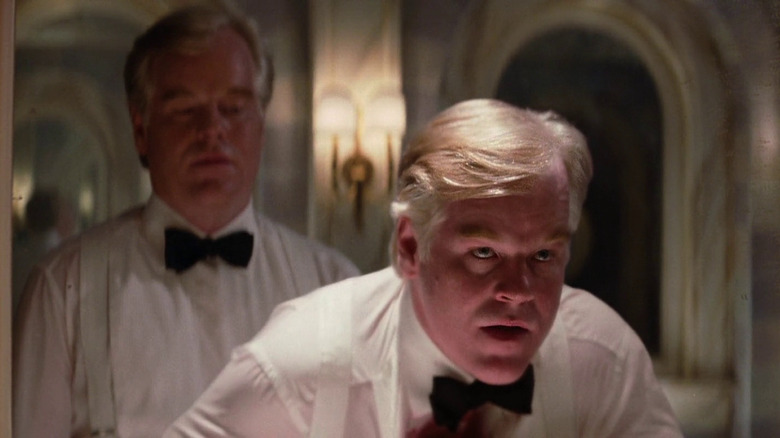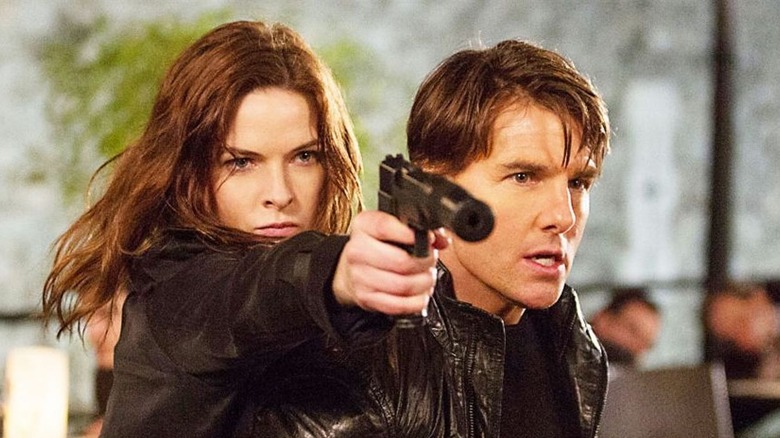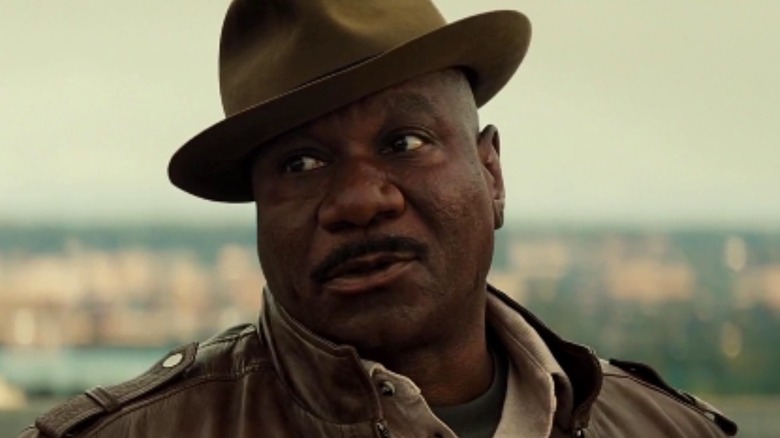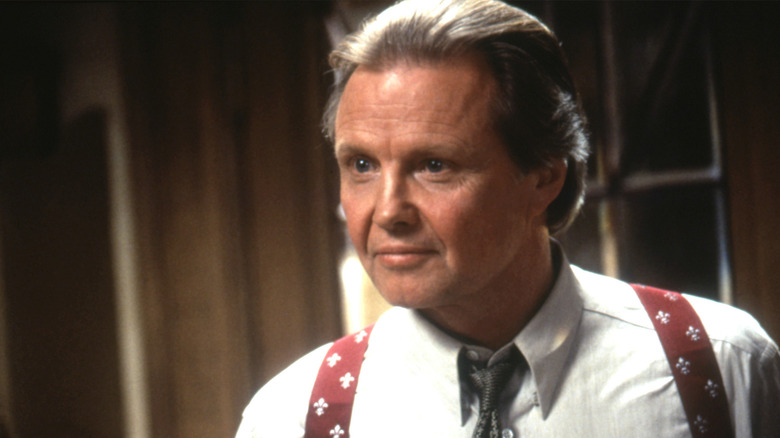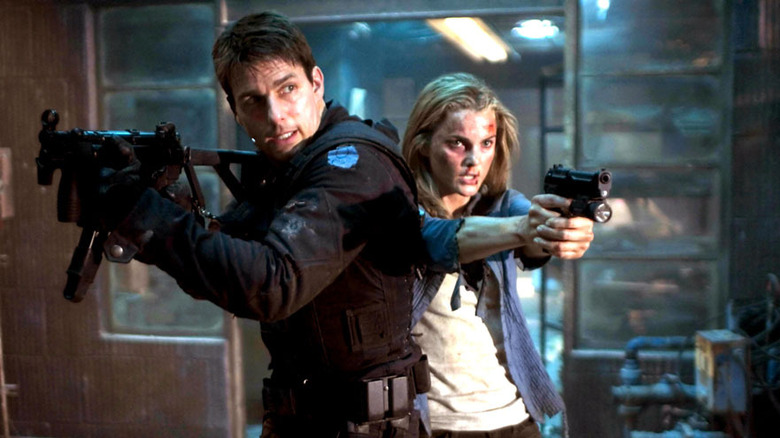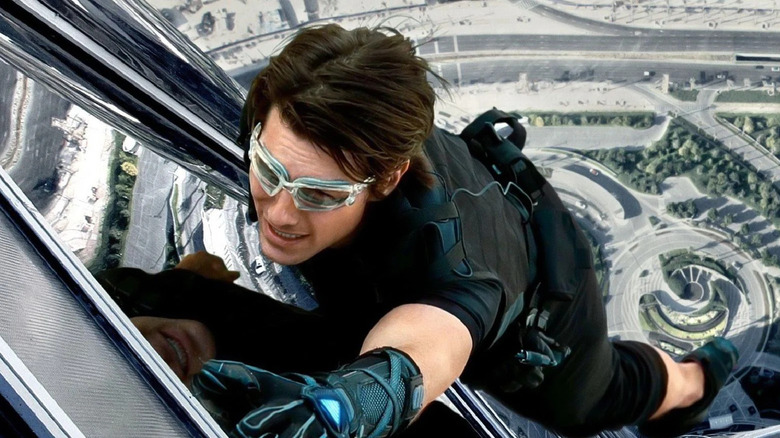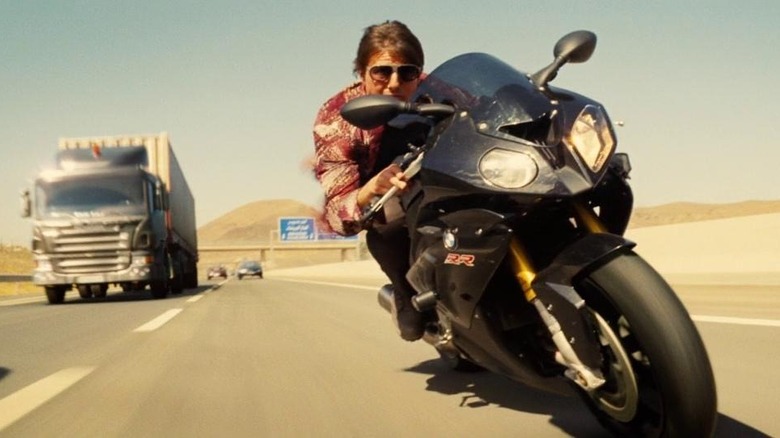Things That Happen In Every Mission: Impossible Movie
One of Hollywood's most successful action movie franchises is the "Mission: Impossible" series, starring Tom Cruise as master spy and daredevil team leader Ethan Hunt. Leading the clandestine government intelligence agency the Impossible Missions Force (IMF), Ethan and his squad of spycraft experts take on high stakes assignments all over the globe to maintain peace and order throughout the free world. And while each of the movies have added their own unique flair, engaging story, and ambitious set pieces, there are recurring elements and tropes that have consistently appeared across the film series as well. And with the "Mission: Impossible" movies not only continuing to build the franchise's success but steadily improve upon themselves, these tropes have only become more cleanly executed than appearing derivative.
Here are all the major features that have prominently appeared in each of the "Mission: Impossible" movies to date, from stylistic flourishes in the franchise's long-running formula to repeated narrative trends that help define Ethan and the IMF's ongoing adventures.
Each movie kicks off with a stylish way to start the opening titles
The "Mission: Impossible" theme by composer Lalo Schifrin is one of the most recognizable themes in the history of television, with its bombastic horns and jazzy rhythm. The opening title sequence to each episode was similarly memorable, with the credits displayed over each of the characters in action as a lit fuse burns in the foreground. This trope was maintained for the movie series, with a decidedly more stylish edge, with each movie differing in how it kicked off this sequence.
The movies have ranged from the more conventional cold open transitioning to the lit fuse opening title sequence to an action incorporated in the prologue itself. "Ghost Protocol" kicks off the sequence with Benji (Simon Pegg) literally lighting the fuse to a bomb while "Rogue Nation" has Ethan pull the ripcord on a parachute. "Mission: Impossible 2" is the only movie that eschews the fuse setup, leaping right into an explosive crash caused by the film's villains before moving to the opening titles.
The mission briefing sets the stakes
Echoing the television series, the "Mission: Impossible" movies include a scene of the IMF field team leader receiving a briefing through a recording. Set to Schifrin's score from the show, the briefing introduces the key figures in a given assignment, the expected mission location, and any other relevant intel to the mission. This briefing concludes with the recorded message always self-destructing shortly after the transmission is complete, with this trend resurfacing in the movies.
The first several "Mission: Impossible" movies keep the briefing scenes relatively faithful to the television show's formula, but begin to twist on this expectation as the film series continues. "Ghost Protocol" has a delayed self-destruction timer, visibly throwing off Ethan after he receives his mission briefing, playing the trope for laughs. "Rogue Nation" gives the briefing a sinister edge, with the presumed briefing being a trap set for Ethan and subverting the expected formula for the audience.
The MacGuffin is always vitally tangible technology or data
A MacGuffin, a plot device that drives the story without being all that significant in and of itself, is a storytelling staple. For the "Mission: Impossible" movies, the MacGuffins are always a tangible item that leads Ethan and the IMF scrambling to keep it out of enemy hands. And given the crypto-thriller nature of "Mission: Impossible," these MacGuffins are always technological in nature, either through crucial data or deadly advancements in weaponry.
The first movie had Ethan using the NOC list, a database of all undercover CIA operatives, as bait to lure out the shadowy villain and clear his own name. Since then, MacGuffins in the film series have ranged from artificial contagions to nuclear devices, all posed to shift the balance of power in the free world. Each of these plot devices give Ethan a tangible target to obtain, often with an accompanying ticking clock component to keep the story moving at a brisk pace.
The IMF team infiltrates a dangerous scenario with an elaborate disguise
The first "Mission: Impossible" movie begins in the vein of many plans from the popular television series, with the IMF team deceiving a target through a set of impressive disguises. Perhaps the most signature gadget from the movies is the Facemaker, a tool capable of creating a hyper-realistic mask modeled after another character's face in a matter of minutes. And while the Facemaker doesn't play a major role in every "Mission: Impossible" movie, the propensity for the IMF team to rely on disguises and impersonations is a franchise staple.
The Facemaker proves key in the first two "Mission: Impossible" movies in helping Ethan outsmart his enemies to save the day. The disguise-crafting device also memorably appears in "Rogue Nation," giving Ethan the time he needs to keep his opponents off-balance. "Ghost Protocol" subverts the expectation to rely on the Facemaker, with the device malfunctioning, though the IMF team scrambles to develop a contingency disguise instead.
Ethan works closely with a femme fatale
In contrast to the much of the James Bond franchise, "Mission: Impossible" has its female characters serve as effective, competent foils to Ethan and integral to the overarching story. From IMF operatives like Zhen Lei (Maggie Q) and Jane Carter (Paula Patton) to arms dealers like Alanna Mitsopolis (Vanessa Kirby), there is no shortage of women who can match skills with Ethan and occasionally surpass him. Ethan has plenty of support from his other teammates staying on the sidelines but these characters, in particular, leave their own mark out on the field.
Given the "Mission: Impossible" franchise's roots in sophisticated spycraft and Cold War paranoia, many of the movies' most memorable women are characters that keep the audience guessing over their true allegiance. Rebecca Ferguson's star-making turn as Ilsa Faust in "Rogue Nation" kept the IMF team rushing just to keep up while uncertain of her loyalty. The first movie's Claire Phelps (Emmanuelle Béart) also kept Ethan unsure if he could completely trust her, leading to a heartbreaking turn by the end of the film.
Luther Stickell remains Ethan's only constant companion
Just as the "Mission: Impossible" television series featured a revolving cast based on what skill sets were needed for a particular assignment, the movies' main cast has similarly changed often. However, the only actor that has appeared in every single "Mission: Impossible" film alongside Cruise is Ving Rhames as IMF tech expert Luther Stickell. And as the movie series has continued, Luther has taken on a more proactive role in the IMF, often joining Ethan in the field.
Introduced in the original film as a disavowed IMF operative recruited by Ethan to clear his name and discover a traitor within the IMF's ranks, Luther has been a steady presence ever since. Luther's most minimal role in the series to date is a cameo at the end of "Ghost Protocol" appearing at the end to share a beer with his old friend. Ethan has been regularly joined by Benji and Ilsa for multiple movies but Luther remains the sole constant teammate for Ethan throughout the franchise.
The IMF and its loyalties are under fire
The IMF is established as one of the most effective and confidential intelligence agencies operating for the United States government, boasting an elite team of operatives in a variety of specializations. Despite this vaunted status within the American intelligence community, IMF personnel and partners tend to rogue, including Ethan and his team on occasion. And this legacy of betrayal and countermanding federal authority has become something of a recurring trope for the movies.
The first "Mission: Impossible" film centered on longtime IMF leader Jim Phelps (Jon Voight) betraying and massacring his own team as he turned into a traitor. 1996 movie's two immediate sequels featured other IMF personnel turning against the American government and their fellow operatives, with Ethan clashing against his old colleagues. Starting with "Ghost Protocol," Ethan and his team tend to be the IMF team that goes against orders, often to save the day on their own terms, bucking IMF leadership and overcoming other double agents.
The IMF's seemingly assured victory is always overturned
Given their high level of expertise and years of experience, victory for the IMF seems virtually guaranteed for the team ... but quickly becomes out of reach. So much of a "Mission: Impossible" movie's opening act is dedicated to meticulous planning and execution to the letter, with each IMF operative demonstrating why they deserve a place on the team. However, even the best-laid plans in every movie are quickly upended by unforeseen complications, leaving the team to scramble.
Many of these reversals of fortune occur with the primary antagonist already anticipating Ethan's next move and responding accordingly. The most gruesome instance of this trope is in the original "Mission: Impossible," with most of the team brutally killed while on a seemingly routine assignment in Prague. Other notable examples are the death of IMF operative Lindsey Farris (Keri Russell) in "Mission: Impossible III" and the destruction of the Kremlin in "Ghost Protocol" just as victory appears assured in both incidents.
Tom Cruise is going to absolutely dazzle the audience with a harrowing stunt
While ostensibly about Ethan leading his fellow IMF operatives in precise spycraft around the world, the "Mission: Impossible" franchise has become synonymous with Cruise's escalating stunt work. With Cruise insisting on performing most of his stunt work himself, the movies are now largely a showcase for death-defying spectacle for Cruise to accomplish. The first film began innocuously enough, with Ethan descending by a taut wire to hack into the CIA, but each subsequent movie has upped the ante with its action set pieces.
Though "Mission: Impossible II" featured impressive enough stunts for Cruise to perform, including Cruise rock climbing in the American Southwest, it was "Ghost Protocol" where this emphasis on stunts became noticeable. The fourth "Mission: Impossible" film had Cruise climb the top of the Burj Khalifa, a towering skyscraper in Dubai, precariously sticking to its glass windows during his ascent. "Rogue Nation" and "Fallout" have featured set pieces of their own, from Cruise clinging to the outside of an airplane taking off to a thrilling rooftop chase in London.
A high-octane chase is a guarantee
It just wouldn't be a blockbuster espionage movie if there wasn't a high-speed chase involved and "Mission: Impossible" remains the gold standard for chase sequences in the genre. And like the action set pieces that have come to define the franchise, each "Mission: Impossible" chase relies increasingly on practical effects and high-octane stunts to dazzle audiences. Many of the resulting chases feature Ethan on foot sprinting through streets and across rooftops, and more than one memorable motorcycle chase has figured prominently in the franchise.
Like many of his other stunts, Cruise performs many of the chases himself, including some impressive helicopter piloting. These chases expertly balance showcasing the international locations where they are filmed and keeping audiences' attention riveted to the pursuers on the big screen. The "Mission: Impossible" movies have come a long way from its first movie having a CG helicopter chase a train into a tunnel, and the franchise is all the better for it.
